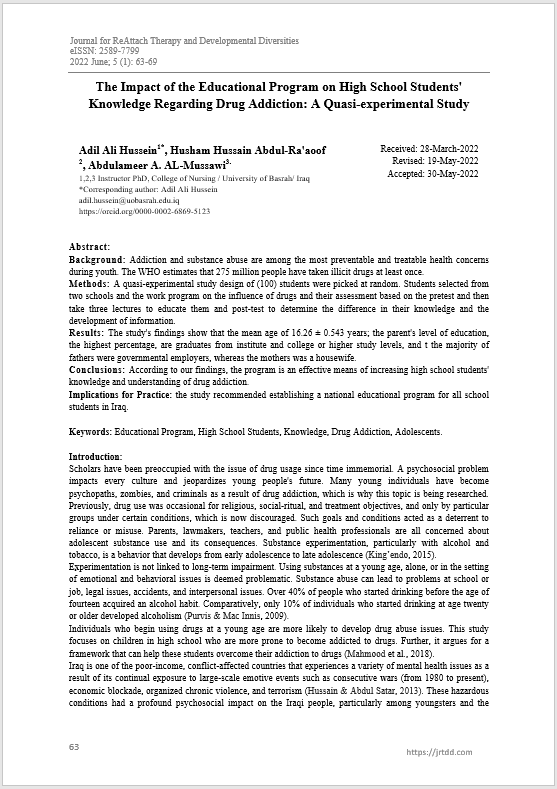The Impact of the Educational Program on High School Students' Knowledge Regarding Drug Addiction: A Quasi-experimental Study
Main Article Content
Abstract
Background: Addiction and substance abuse are among the most preventable and treatable health concerns during youth. The WHO estimates that 275 million people have taken illicit drugs at least once.
Methods: A quasi-experimental study design of (100) students were picked at random. Students selected from two schools and the work program on the influence of drugs and their assessment based on the pretest and then take three lectures to educate them and post-test to determine the difference in their knowledge and the development of information.
Results: The study's findings show that the mean age of 16.26 ± 0.543 years; the parent's level of education, the highest percentage, are graduates from institute and college or higher study levels, and t the majority of fathers were governmental employers, whereas the mothers was a housewife.
Conclusions: According to our findings, the program is an effective means of increasing high school students' knowledge and understanding of drug addiction.
Implications for Practice: the study recommended establishing a national educational program for all school students in Iraq.
Article Details
References
Al Rikabi, L. Y. (2011). The causes of substance use among middle school students. Psychol Sci, 19, 75-106.
Al‐Hemiery, N., Dabbagh, R., Hashim, M. T., Al‐Hasnawi, S., Abutiheen, A., Abdulghani, E. A. & Rawson, R. A. (2017). Self‐reported substance use in Iraq: findings from the Iraqi National Household Survey of Alcohol and Drug Use, 2014. Addiction, 112(8), 1470-1479.
Alhyas, L., Al Ozaibi, N., Elarabi, H., El-Kashef, A., Wanigaratne, S., Almarzouqi, A., ... & Al Ghaferi, H. (2015). Adolescents’ perception of substance use and factors influencing its use: a qualitative study in Abu Dhabi. Jrsm Open, 6(2), 2054270414567167.
Bengali, R. M. S. (2016). Iran’s growing drug problem:‘No walk of society is immune’. Los Angeles Times.
Bruno, T. L., & Csiernik, R. (2020). An examination of universal drug education programming in Ontario, Canada’s elementary school system. International Journal of Mental Health and Addiction, 18(3), 707-719.
Geramian, N., Akhavan, S., Gharaat, L., Tehrani, A. M., & Farajzadegan, Z. (2012). Determinants of drug abuse in high school students and their related knowledge and attitude. J Pak Med Assoc, 62(3 Suppl 2), S62-66.
M. J. Traum, J. Fiorentine. (2021). Rapid Evaluation On-Line Assessment of Student Learning Gains for Just-In-Time Course Modification. Journal of Online Engineering Education, 12(1), 06–13. Retrieved from http://onlineengineeringeducation.com/index.php/joee/article/view/45
Goswami, Y. P. (2015). A Study to Assess the Effectiveness of Structured Teaching Programme on Knowledge regarding Substance Abuse among Adolescents at Selected Nursing.
Hussain, H. Y., & Abdul Satar, B. A. (2013). Prevalence and determinants of tobacco use among Iraqi adolescents: Iraq GYTS 2012. Tobacco induced diseases, 11(1), 1-4.
Isensee, B., Hansen, J., Maruska, K., & Hanewinkel, R. (2014). Effects of a school-based prevention programme on smoking in early adolescence: a 6-month follow-up of the ‘Eigenständig werden’cluster randomised trial. BMJ open, 4(1), e004422.
King’endo, M. (2015). Behaviour Disorders Related to Drug Abuse Among Secondary School Students in Kenya.
Inna Rakhmawati, Anak Agung Ayu Mirah Adi, Ida Bagus Oka Winaya, Palagan Senopati Sewoyo. (2022). In Vivo Oncolytic Potency of Newcastle Disease Virus Gianyar-1/AK/2014 Virulent Strain Against Mice Fibrosarcoma Models. Revista Electronica De Veterinaria, 56 - 63. Retrieved from https://www.veterinaria.org/index.php/REDVET/article/view/139
Lafta, R. K., Al Shawi, A. F., Al Nuaimi, A. S., & Al Hasnawi, S. (2015). Impact and relationship of childhood experiences and substance abuse in a population of Baghdad City, Iraq. South East Asia Journal of Public Health, 5(1), 25-32.
Mahmood, N., Othman, S., Al-Tawil, N., & Al-Hadithi, T. (2018). Impact of an education intervention on knowledge of high school students concerning substance use in Kurdistan Region-Iraq: A quasi-experimental study. PloS one, 13(10), e0206063.
Purvis, G., & Mac Innis, D. (2009). Implementation of the Community Reinforcement Approach (CRA) in a long-standing addictions outpatient clinic. Journal of Behavior Analysis in Health, Sports, Fitness and Medicine, 2(1), 32.
Rockville, M. D. (2009). Substance Abuse and Mental Health Services Administration. Center for Substance Abuse Treatment.
Shalini, D. V., & Nayak, M. (2011). Awareness and impact of education on breast self examination among college going girls. Indian journal of palliative care, 17(2), 150.
Theou, C., Nayak, A. K., & Jose, T. T. (2015). A study to determine the effectiveness of an awareness programme on knowledge on substance abuse and its consequences among the students of a selected pre university college of Udupi district, Karnataka. Journal of Health and Allied Sciences NU, 5(01), 053-057.

